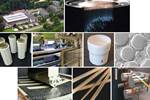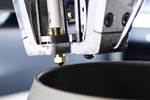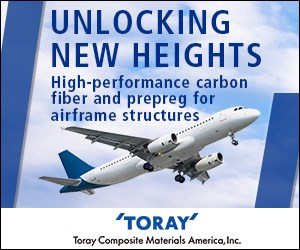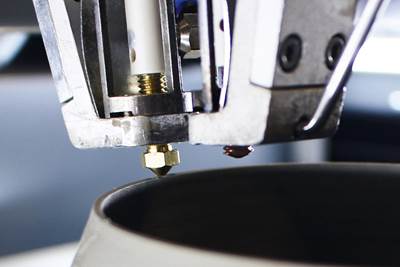Arceon (Delft, Netherlands) produces a family of ceramic matrix composites (CMC) called Carbeon which comprise uncoated carbon fiber reinforcement in a carbon-silicon carbide matrix (C/C-SiC) made using a melt infiltration process. “We are producing parts for space and defense applications,” says CEO Rahul Shirke, but also notes developments in a range of other markets, including metal treatment and other industrial processes, battery enclosures, friction and wear applications, high-precision and analysis equipment, and more. (See CW’s August 2024 news post, “Arceon introduces novel CMC materials for space, defense”)
“The two main challenges we target is being able to handle extreme temperatures and thermal shock with materials that are lightweight,” says Shirke. “We have tested Carbeon materials for 2 hours at 1600°C and observed only 1% mass loss. And yet it’s two to four times lighter than current metal alloys used. Also, our process gives the lowest porosity and density for this type of C/C-SiC material — 1.9 gram per cubic centimeter [g/cm3].” This low porosity helps provide better mechanical properties but also performance in thermal protection system (TPS), including ablative systems that must withstand reentry into Earth’s atmosphere, for example. “Lower porosity provides better TPS versus high porosity, where ablation occurs at a faster rate because heat is going to penetrate inside the material more quickly,” says Shirke.
Arceon’s goal is to help enable not only reusable space vehicles, but also high-precision components for space communications as well as high-temperature industrial and transport applications on Earth. “We want to empower innovations with materials designed for high performance in extreme environments.”
Company history
Arceon was founded in 2018 by Rahul Shirke (CEO) and co-founded with Rahul Sharma (COO) and Bernhard Heidenreich (CTO). Shirke and Sharma are alumni from the Delft University of Technology (TU Delft) while Heidenreich has more than 25 years of experience with CMC at the German Aerospace Center (DLR) Institute of Structures and Design (Stuttgart, Germany).
The startup was selected by the Netherlands Space Office and the European Space Agency (ESA) European Space Research and Technology Centre (ESTEC) — the technical heart of ESA, located in Noordwijk, the Netherlands — to participate in the ESA BIC Noordwijk business incubation program. Arceon successfully graduated from the program in 2023 and completed first and second funding rounds in March 2023 and October 2024. The following month, its CMC materials were launched into space on NASA’s SpaceX 31st resupply mission to the International Space Station (ISS) as part of the Europe Material Ageing (EMA) campaign, a collaboration between the ESA and the French Space Agency (CNES).
Arceon in multiple ESA programs
EMA. Four Carbeon materials were included in 45 samples for the EMA campaign. These will be tested for ≈1 year on Bartolomeo, a platform attached externally to the European Columbus Module of the ISS. The samples will be exposed to the harsh conditions of space, including radiation, vacuum, sudden shifts in temperature from -150°C to 150° C and even space debris. The goal is to provide insight about how materials age in low-Earth orbit (LEO).
NASA astronaut and Expedition 72 commander Sunita Williams works with the European Materials Ageing hardware inside the International Space Station (ISS). Once installed, 45 materials will be exposed to the conditions of space for ≈1 year. Source | NASA Flickr photostream and European Space Agency (top)
Materials for EMA were first qualified at ESA ESTEC ground test facilities simulating space conditions, but Bartolomeo will help to calibrate these facilities against the real environment of space and also perform additional research, such as analyzing degradation mechanisms.
“Our materials were declared as having no detectable outgassing and negligible ATOX [atomic oxygen] erosion material,” says Shirke. “Outgassing is the property of the material to release elements which are present inside the material. If there are alien particles on the optical mirror, then it can hinder its accuracy. This lack of outgassing enables it to be placed near optical mirrors.” Meanwhile, he notes that Carbeon’s ATOX erosion was two orders of magnitude lower than common carbon fiber-reinforced polymer (CFRP) materials used in space.
CASTT for mirrors, telescopes. In the CASTT project (June 2024 – June 2025), Arceon is working with ESA to demonstrate the use of its C/C-SiC materials in mirror supports for future optical/laser communications. “The objective is to de-risk the use of Carbeon by understanding its co-efficient of thermal expansion [CTE] performance and behavior with optical mirrors,” says Shirke. “This includes looking at assembly and integration of mirrors and metal components with Carbeon components and durability with respect to launch loads by performing vibration tests.” He notes that CASTT is meant to complement EMA.
Another part of CASTT involves collaboration with the Netherlands Organisation for Applied Scientific Research (TNO, The Hague), where Arceon will design, develop and test a Carbeon telescope tube structure. “This project aims to determine if our material can be considered for future space telescopes and to validate its potential benefits such as lightweight and near-zero CTE to avoid out-of-focus mirrors due to temperature changes.”
Reusable rockets. Arceon announced in December 2024 that it has been selected to participate in a third ESA project, this time in collaboration with prime contractor The Exploration Co. (Munich, Germany and Bordeaux, France). “We will be developing a component for a high-thrust staged combustion engine,” says Shirke, adding that this is part of the Technologies for High-thrust Re-Usable Space Transportation (THRUST!) project, an ESA initiative to mature reusable rocket technology. The project will target thrust levels of 500-1,500 kilonewtons for first stages or boosters and more than 1,500 kilonewtons for future heavy-lift launchers.
Carbeon has already demonstrated its Carbeon-UHT material in rocket nozzles, able to withstand the sudden increase from room temperature to more than 2000°C and maintain its structural properties.
Carbeon product family
Carbeon can be highly tailored to meet specific application requirements by optimizing its material design and manufacturing parameters.
Carbeon-HPS is tailored for high-precision systems, combining fiber architecture and design expertise to obtain near-zero CTE with significant weight reduction. Optics, opto-mechanical systems, medical and analysis equipment, lithography, laser and calibration systems.
Carbeon-UHT offers ultra-high temperature resistance and tailored thermal conductivity, offering materials 3 times lighter than superalloys while withstanding higher temperatures in a non-oxidizing environment. Reusable rocket nozzles, thermal protection systems, hot gas liners, kiln furniture, industrial process fixtures.
Carbeon-LWR provides long-term wear and abrasion resistance with tailored coefficient of friction for braking or sliding elements and low density that provides ease of control for fast-moving or accelerated components. Bearings, brake discs/pads, sealing rings, components in trains, elevators, wind turbines.
Why melt infiltration?
Shirke explains there are three main processes used in the industry to produce CMCs: chemical vapor infiltration (CVI), polymer infiltration and pyrolysis (PIP) and melt filtration (MI). “The drawback with CVI is that it takes almost five densification cycles (2 months) to manufacture the CMC,” says Shirke. “Also, the raw materials are expensive, and you end up with more than 10% porosity. The PIP process has similar performance and limitations.
“Alternatively, the MI process requires a single densification cycle (1 week) and results in only 1-3% porosity,” continues Shirke. “Not only is it a faster process, but it’s also economical because there are no exotic raw materials and no coatings on the fiber. That is why we use MI and how we have managed to keep the cost down. We want to target commercial applications with Carbeon, not just develop it as a set of high-performing exotic products.”
One of the drawbacks of MI is the creation of residual silicon in the resulting CMC, concedes Shirke. “Carbeon has less than 5% residual silicon, and if needed, we can remove that.”
Coating carbon fiber in CMC
Using carbon fiber in CMC is attractive because it retains high mechanical properties above 2000°C yet is low cost compared to fine ceramic fibers. However, above 450°C significant oxidation will begin, where oxygen reacts with the fiber surface. This results in mass loss and decreased fiber diameter and tensile strength, which further reduces with increasing temperature and exposure duration. Thus, most carbon fiber used in CMC requires a fiber coating to protect against oxidation.
These coatings are also used to provide a soft, weakly bonded interface that promotes progressive failure mechanisms to enable toughness in the CMC. However, if matrix cracks occur and then reach a coated fiber, the coating and the fiber are susceptible to oxygen ingress and oxidation.
Pyrolitic carbon (PyC) and boron nitride (BN) are common coatings used in CMC that can be deposited on carbon fiber using chemical vapor deposition (CVD) at temperatures of 1200-2500°C for PyC and 800-1200°C for BN. However, these fiber coating processes are slow and costly.
“Our competitors that use the melt infiltration process coat the fibers to protect them against the molten silicon during the infiltration process,” says Shirke. “But these coatings add stiffness and restrict the deformation of the fibers, which results in design limitations. Thus, we prefer a solution without coatings.”
Process steps
The MI process that Arceon uses involves three steps:
- Manufacturing the CFRP part.
- Pyrolysis to form a porous C/C preform.
- Infiltration of molten silicon to form the C/C-SiC composite.
“In the first step, we produce a CFRP part using a precursor polymer and carbon fiber,” says Shirke, “The polymer is a proprietary phenolic that enables our process.” The CFRP can be made using filament winding, prepreg layup with autoclave cure, resin transfer molding into a preform or hot pressing of impregnated chopped fiber, for example.
“The second step is pyrolysis,” says Shirke. “Here, the polymer matrix is converted to a glassy carbon matrix, accompanied by volume shrinkage which leads to internal stresses and formation of matrix cracks. The resulting carbon fiber-reinforced carbon [C/C] preform has a high open porosity but is stable enough for safe handling and machining. In the final step, the pores will be infiltrated with molten silicon (Si). Note, the microstructure of the C/C preform is important for this infiltration and the properties of the final CMC material. It is influenced mainly by the strength of the fiber matrix bonding (FMB) which is able to protect the fibers from Si-attack during siliconization and enables the final quasi-ductile, damage-tolerant C/C-SiC material.
“And in the third step, we know exactly how much silicon has to be infiltrated to get a homogeneous distribution and proper balance between the carbon, SiC and residual Si content in the matrix. If it is higher in Si or SiC content, then the result is brittle. We understand how to avoid that.”
The resulting Carbeon material or part looks metallic, but becomes matte after machining, which is often required to ensure precise geometry and tolerances after shrinkage.
Patented designs, joining
“Our strategy is not to patent the process but instead the design features of the Carbeon product,” he explains. He shows a typical convergent-divergent nozzle (at right, below) made with Arceon’s three-step process. “This is a complex part to make in one shot. Instead, we use simple molds for the two different cones and press form them using chopped fiber in the first step. After the second pyrolysis step, we join the two parts using a paste and then infiltrate them together in the last step. The result is an integrated single part where you cannot see the joint anymore.
A divergent section (lower cone) and convergent section (top cone) are joined after pyrolysis and then infiltrated with silicon to form an integrated, solid rocket nozzle. CT images show the quality of the joint. Source | Arceon
“So, we are patenting the unique features of this Carbeon part’s design, which includes our joining technique,” continues Shirke. “And this technique works well because we use the same material in the parts to join the parts. This is really important because it means the joint is stable at high temperatures because there is no lower temperature adhesive or other material there.”
There are other approaches to joining, says Shirke. “You can use adhesives and they can work really well with CMC, but it depends on the application. Alternatively, you can geometrically lock parts together or have some mechanical joining. Brazing can also be used, but it’s difficult and time-consuming, which increases cost.”
Applications, future growth
“We are also looking at using our materials in wear pad and bearing applications,” he adds, “where C/C has already been validated for decades in brake pads, for example. We are also working with some electrical aviation companies that are interested in Carbeon sheets for battery packs. Here, the regulations are quite strict with respect to containment if the battery catches fire, and our material is lightweight yet can withstand the very high temperatures of such fires.”
For now, all of the parts Arceon is developing are less than 1 meter long. “We do have a supply chain we can deploy for larger parts and quantities,” notes Shirke. “As a startup, we wanted to keep our overhead low, and there are a lot of local companies with composites manufacturing expertise. So, when necessary, we have capacity we can rent. But as the company grows, larger size and volume capabilities will be brought in-house.”
Performance of Carbeon versus other materials in a rocket nozzle (top) and nozzle extension being tested (bottom). Source | Arceon, The Exploration Co/
He adds that Arceon is also working on ultra-high temperature CMC (UHTCMC) using its MI process. “Our focus is to make UHTCMC cost efficient and easy to scale up,” says Shirke. “We have initiated this project with Delft University of Technology in the Netherlands and anticipate our first results later in 2025.

Test of Carbeon CMC leading edge (left) and samples before and after testing (right). Source | Arceon
“Our next development is to deploy solid rocket motor nozzles which compete with graphite on cost but with increased performance,” he continues. Arceon successfully tested a Carbeon leading edge for a hypersonic vehicle in late 2024. Located 100 millimeters from the nozzle exit, it survived a test environment representing a temperature of 1500 Kelvin, speed of 2,450 meters/second and flow density of 0.2 kilograms per cubic meter (kg/m3).
“We will be manufacturing near-net-shape components which require minimum machining, and are executing this project with companies in the Netherlands and U.K.” Indeed, Arceon is working with multiple companies in the EU and U.K. to develop structural CMC components for next generation defense systems as part of the Hypersonic Technologies & Capability Development Framework (HTCDF).
Arceon has also sampled Carbeon materials to multiple organizations worldwide. “We have an export license and can ship plates and other samples without needing any design information,” notes Shirke. “We will also set up a presence in the U.S. in 2025.”
Related Content
Bio-based acrylonitrile for carbon fiber manufacture
The quest for a sustainable source of acrylonitrile for carbon fiber manufacture has made the leap from the lab to the market.
Read MoreComposites manufacturing for general aviation aircraft
General aviation, certified and experimental, has increasingly embraced composites over the decades, a path further driven by leveraged innovation in materials and processes and the evolving AAM market.
Read MoreWelding is not bonding
Discussion of the issues in our understanding of thermoplastic composite welded structures and certification of the latest materials and welding technologies for future airframes.
Read MoreCryo-compressed hydrogen, the best solution for storage and refueling stations?
Cryomotive’s CRYOGAS solution claims the highest storage density, lowest refueling cost and widest operating range without H2 losses while using one-fifth the carbon fiber required in compressed gas tanks.
Read MoreRead Next
On the radar: Reusable launch vehicles, hypersonics make space more accessible
CFRP has become key to targeting efforts in reusing components like rocket stages, as well as the development of reusable hypersonic testbeds and spaceplanes, for increasing space commercialization.
Read MoreDITF Denkendorf advances sustainable carbon fibers, oxide fibers for CMC and more
The German Institutes of Textile and Fiber Research are targeting more sustainable carbon fiber via low-pressure stabilization and bio-based precursors, and working with Saint-Gobain to commercialize oxide ceramic fibers for CMC.
Read MoreA new era for ceramic matrix composites
CMC is expanding, with new fiber production in Europe, faster processes and higher temperature materials enabling applications for industry, hypersonics and New Space.
Read More



























